7 Unbiased Energy Australia Solar Reviews for 2025
Choosing the right solar retailer can feel like navigating a maze of feed-in tariffs (FiTs), complex billing, and shifting customer service experiences.Choosing the right solar retailer can feel like navigating a maze of feed-in tariffs (FiTs), complex billing, and shifting customer service experiences. For many Australian homeowners, EnergyAustralia is a major contender, but what do existing customers actually say? Standard retailer websites only show you one side of the story. To get the full picture, you need to dig into independent analysis and unfiltered customer feedback.
This roundup cuts through the marketing noise, bringing together seven essential resources for comprehensive Energy Australia solar reviews. We'll explore everything from the official tariff structures and how they have changed, to raw, honest feedback on platforms like ProductReview and Trustpilot. Each entry includes direct links and screenshots to help you quickly find the information you need. We will also look at expert analysis from solar industry watchdogs, giving you a balanced view to help you decide if EnergyAustralia is the right partner for your solar journey.
By the end of this guide, you’ll have a clear, multi-faceted understanding of their performance, strengths, and weaknesses, based on real-world data and experiences. You will be equipped to make an informed decision, armed with a complete picture of what to expect from their solar plans and customer support.
1. EnergyAustralia – The Official Source for Tariffs, Plans, and Support
Before diving into third-party Energy Australia solar reviews, your first and most critical step should be to consult the official source. The EnergyAustralia website is the definitive place to find the most current, state-specific information on their solar plans, feed-in tariffs (FiTs), and associated policies. This is the baseline against which all other reviews and claims should be measured.
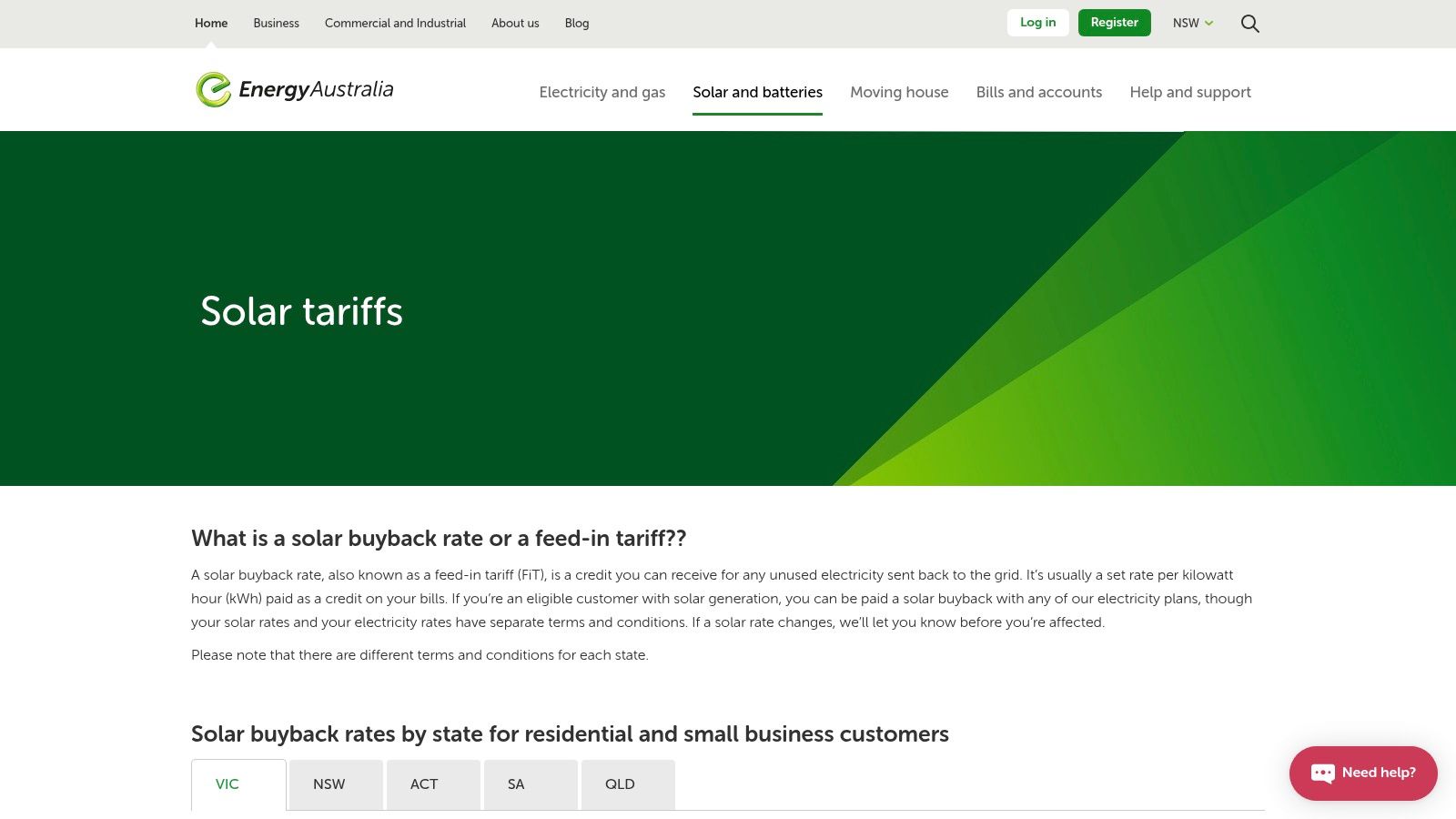
The platform provides detailed breakdowns of their solar offerings, including the tiered ‘Solar Max’ plan, which often provides a higher FiT for an initial block of daily exported energy. Understanding this structure is crucial for accurately forecasting your potential savings. While the site is naturally promotional, it offers transparent access to the essential data you need.
How to Use the Site Effectively
To get the most value, navigate directly to their solar feed-in tariff section. Here, you can select your state to see the specific rates applicable to your home.
- Verify FiT Rates: Use this section to confirm the cents-per-kilowatt-hour (c/kWh) rate mentioned in any customer review. FiTs change, so verifying the current rate is essential.
- Understand Plan Compatibility: The site clearly explains how having a solar system impacts your eligibility for plans like the fixed-rate Secure Saver.
- Check Export Charges: Find detailed FAQs explaining how two-way or export charging policies work, which is a growing consideration for solar owners.
This website is also where you can find information on how their solar plans integrate with broader energy initiatives. For those with a battery, understanding how your system can participate in a larger network is the next step in maximising value; you can learn more about how a Virtual Power Plant in Australia operates and what the benefits are.
Pros & Cons of Using the Official Website
| Pros | Cons |
|---|---|
| ✅ Most up-to-date, official FiT information. | ❌ FiTs can change periodically, even mid-contract. |
| ✅ Clear guidance on solar plan compatibility. | ❌ Policy language can sometimes be confusing for newcomers. |
| ✅ Direct access to Terms & Conditions for solar plans. | ❌ Lacks independent, real-world customer feedback. |
Website: https://www.energyaustralia.com.au/home/solar/feed-in-tariffs
2. ProductReview.com.au – Consumer reviews of EnergyAustralia
After checking the official source, your next port of call for genuine Energy Australia solar reviews should be ProductReview.com.au. As one of Australia's largest local consumer review platforms, it hosts thousands of unfiltered testimonials from real customers, offering a ground-level view of what it’s actually like to be a solar customer with EnergyAustralia. This is where you’ll find raw feedback on everything from feed-in tariff satisfaction to billing accuracy and customer support responsiveness.
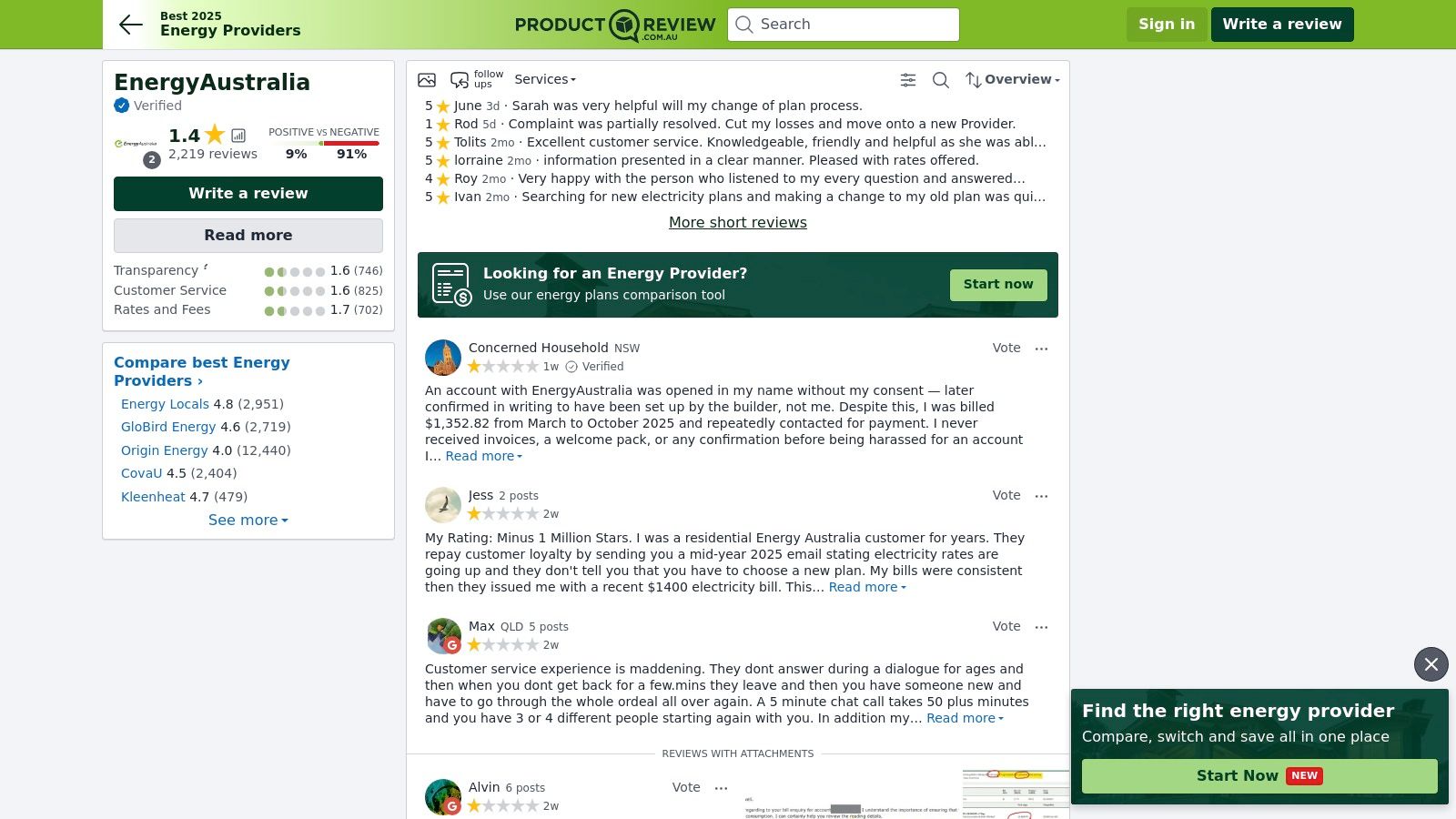
This platform excels at providing context that official websites simply can't. You can read detailed anecdotes about specific issues, such as delays in bill credits for solar exports or positive experiences with their support team when resolving a complex solar-related query. The sheer volume of reviews gives you a strong sense of recurring themes and allows you to gauge current customer sentiment before committing.
How to Use the Site Effectively
To get the most relevant information, use the platform’s filtering tools. Sorting reviews by "Most Recent" is crucial for understanding the current state of service, as energy policies and FiTs can change quickly.
- Search for Solar Keywords: Use the search bar within the EnergyAustralia reviews section to look for terms like "solar," "FiT," "feed-in," or "battery" to find the most relevant customer stories.
- Filter by Rating: Read a mix of 5-star and 1-star reviews. The positive ones often highlight what the company does well, while the negative ones reveal potential pain points you should be aware of.
- Check Review Timelines: Pay attention to when a review was posted. Feedback from the last six months is far more indicative of current service levels than reviews from several years ago.
This website is invaluable for its side-by-side comparisons, allowing you to quickly see how EnergyAustralia’s overall rating stacks up against other major energy retailers. While the feedback is subjective, the patterns that emerge from hundreds of Energy Australia solar reviews provide an indispensable layer of real-world insight.
Pros & Cons of Using ProductReview.com.au
| Pros | Cons |
|---|---|
| ✅ Strong local relevance with many solar-specific anecdotes. | ❌ Reviews are subjective and may skew negative or positive. |
| ✅ Highlights real customer service and billing resolution timelines. | ❌ Not an official source for specs; details need verification. |
| ✅ Large volume of recent reviews offers a current snapshot. | ❌ Individual experiences may not reflect the average customer's. |
Website: https://www.productreview.com.au/listings/energyaustralia
3. Trustpilot – EnergyAustralia customer feedback
For an unfiltered look into real-world customer sentiment, Trustpilot is an invaluable resource. This global review platform hosts thousands of date-stamped Energy Australia solar reviews and general customer feedback, providing a transparent view of both positive and negative experiences. It’s an excellent place to gauge overall satisfaction and identify recurring issues that official sources might not highlight.
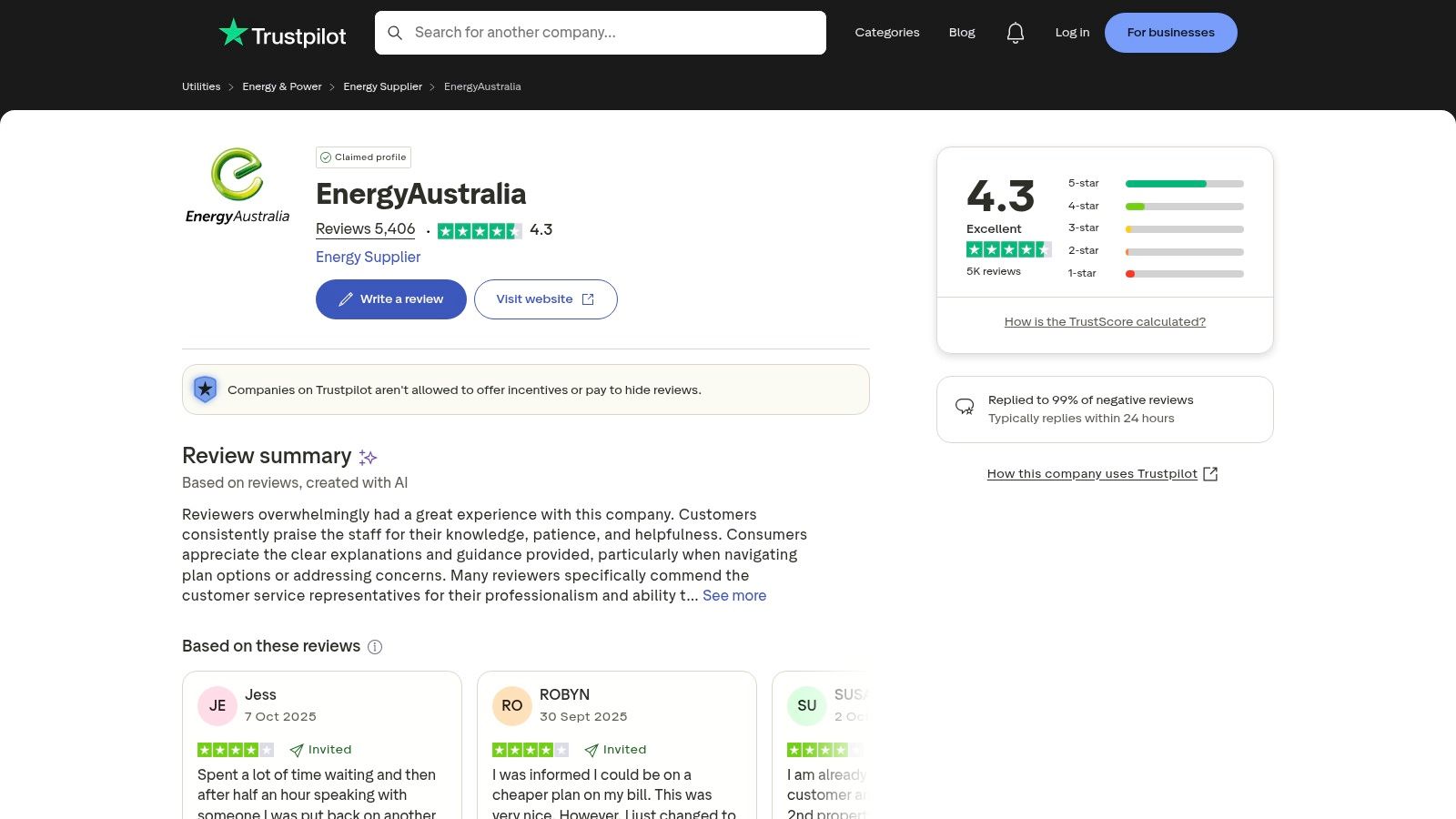
What makes Trustpilot particularly useful is the sheer volume of reviews and the direct company responses. You can see how EnergyAustralia’s support team publicly addresses complaints, offering insight into their customer service processes. This dynamic allows you to assess not just the problems customers face, but also how the company attempts to resolve them.
How to Use the Site Effectively
To get the most relevant information, use the search function within the EnergyAustralia profile to filter reviews containing terms like "solar," "feed-in," or "FiT."
- Analyse Recent Trends: Sort reviews by "Most recent" to understand current issues, especially after a price change or policy update.
- Evaluate Company Responses: Look for patterns in how EnergyAustralia replies to negative feedback. Do they offer genuine solutions or use generic, copy-paste answers? This is a key indicator of their customer service quality.
- Identify Common Themes: Scan for recurring complaints related to solar billing errors, unexpected drops in feed-in tariffs, or difficulties in getting solar-specific issues resolved.
While individual reviews can be subjective, the collective sentiment on Trustpilot provides a powerful data point. It helps you build a more balanced picture by contrasting the official marketing messages with the lived experiences of actual solar customers.
Pros & Cons of Using Trustpilot
| Pros | Cons |
|---|---|
| ✅ High volume of recent, unfiltered customer feedback. | ❌ An open platform where review authenticity can be debated. |
| ✅ Company replies offer insight into their resolution process. | ❌ Negative experiences are often over-represented. |
| ✅ Easy to search for solar-specific keywords and themes. | ❌ Should be treated as one data point, not the sole source of truth. |
Website: https://au.trustpilot.com/review/energyaustralia.com.au
4. Canstar Blue – EnergyAustralia solar plan and FiT explainer
While the official site provides the definitive data, independent comparison platforms like Canstar Blue are essential for contextualising Energy Australia solar reviews within the broader market. Canstar Blue acts as an independent aggregator, summarising and timestamping feed-in tariff data by state. This provides a quick and clear benchmark for how EnergyAustralia's offerings stack up against other retailers.
The platform excels at distilling complex information into easily digestible formats. For instance, it provides a clear explanation of Victoria's time-of-use (TOU) feed-in tariff structure, helping users understand how their export earnings can vary depending on the time of day. This is crucial for Victorian households aiming to maximise their solar investment returns.
How to Use the Site Effectively
Canstar Blue is best used as a high-level comparison and verification tool. Its organised tables allow you to quickly assess EnergyAustralia’s rates across different states without navigating through multiple pages on the official website.
- Benchmark FiT Rates: Use the tabulated data for NSW, VIC, QLD, SA, and ACT to see how EnergyAustralia's rates compare to market averages and competitor offers.
- Understand Special Tariffs: Read the detailed explanations on complex structures like the Victorian TOU FiT to grasp how your export habits will affect your savings.
- Check Timestamps: Pay close attention to the source timestamps on their data. This tells you how recently the information was verified and helps you decide if you need to cross-check with EnergyAustralia's site for the latest figures.
This platform bridges the gap between official data and real-world market context, making it a valuable second stop after visiting the EnergyAustralia website.
Pros & Cons of Using Canstar Blue
| Pros | Cons |
|---|---|
| ✅ Clear, digestible summaries easy to cross-check. | ❌ FiT rates are snapshots and may lag behind the latest updates. |
| ✅ Good for benchmarking EnergyAustralia against competitors. | ❌ Does not provide in-depth, user-generated customer reviews. |
| ✅ Explains complex tariff structures like TOU FiTs simply. | ❌ The focus is on rates rather than customer service experiences. |
Website: https://www.canstarblue.com.au/solar/solar-panel-installers/energyaustralia-solar/
5. SolarQuotes – News and analysis on EnergyAustralia FiT changes
While retailer and review sites provide crucial data points, SolarQuotes offers a layer of independent, expert analysis that is essential for a complete picture. This leading Australian solar education platform provides plain-English news and deep-dive articles that deconstruct Energy Australia solar reviews and tariff changes. It's the ideal resource for understanding the real-world impact of policies like the Solar Max plan and its export caps.
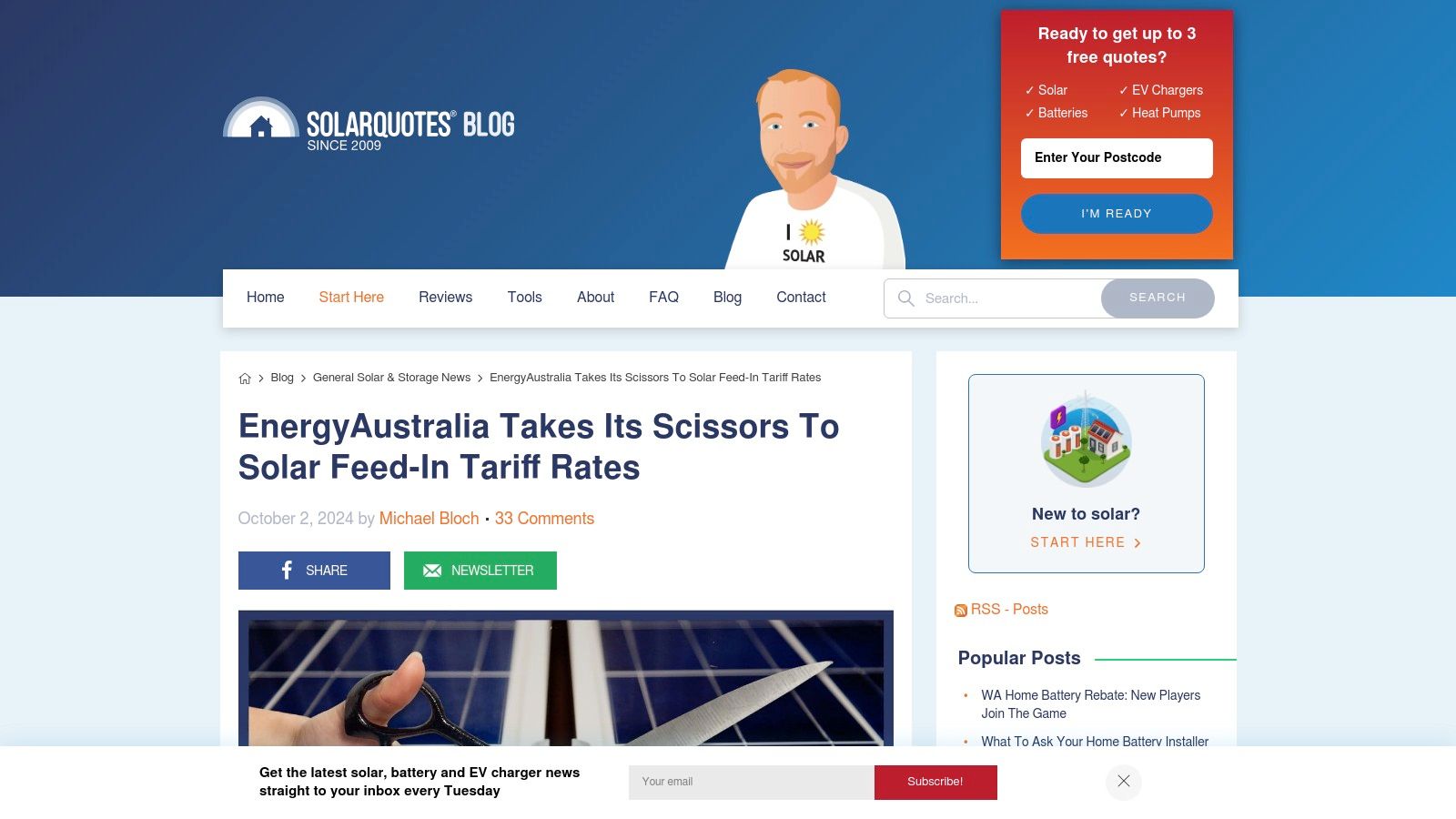
SolarQuotes excels at translating complex tariff structures into practical advice. Instead of just listing the feed-in tariff rate, their articles explain the trade-offs involved, such as whether a higher FiT on a specific plan is worth forgoing other discounts on your energy usage. This level of specialist commentary helps you make a more informed financial decision based on your specific household consumption and export patterns.
How to Use the Site Effectively
The platform's blog is a goldmine of information. Use their search function to find articles specifically discussing EnergyAustralia's latest tariff adjustments to get historical context and forward-looking analysis.
- Understand Export Caps: Read their detailed breakdowns of how tiered FiTs like Solar Max work, clarifying that the attractive higher rate only applies to a limited amount of daily exported energy.
- Analyse Historical Trends: Use their articles to see how EnergyAustralia's FiTs have changed over time in your state, helping you understand market direction.
- Calculate True Value: The analysis helps you weigh the benefits of a high FiT against potential drawbacks. It's an excellent primer before deciding if VPPs or feed-in tariffs will put more money in your pocket.
This expert analysis equips you with the knowledge to not just read reviews, but to understand the fundamental drivers behind them.
Pros & Cons of Using SolarQuotes
| Pros | Cons |
|---|---|
| ✅ Independent, solar-specialist commentary. | ❌ Content is analysis, not an official tariff listing. |
| ✅ Helps quantify trade-offs between FiT plans and other discounts. | ❌ Historical articles may contain outdated FiT rates. |
| ✅ Plain-English explanations of complex energy policies. | ❌ May not cover niche or less common plan variations. |
Website: https://www.solarquotes.com.au/blog/ea-solar-tariffs-mb3020/
6. Selectra Australia – EnergyAustralia solar review and FiT snapshots
For those seeking a consolidated, third-party perspective, Selectra Australia offers a powerful one-stop overview of EnergyAustralia’s solar offerings. It functions as an energy comparison and research platform, aggregating key data points, customer sentiments, and expert commentary into a single, easy-to-digest page. This makes it an excellent resource for getting a quick yet comprehensive understanding of how EnergyAustralia stacks up in the market.
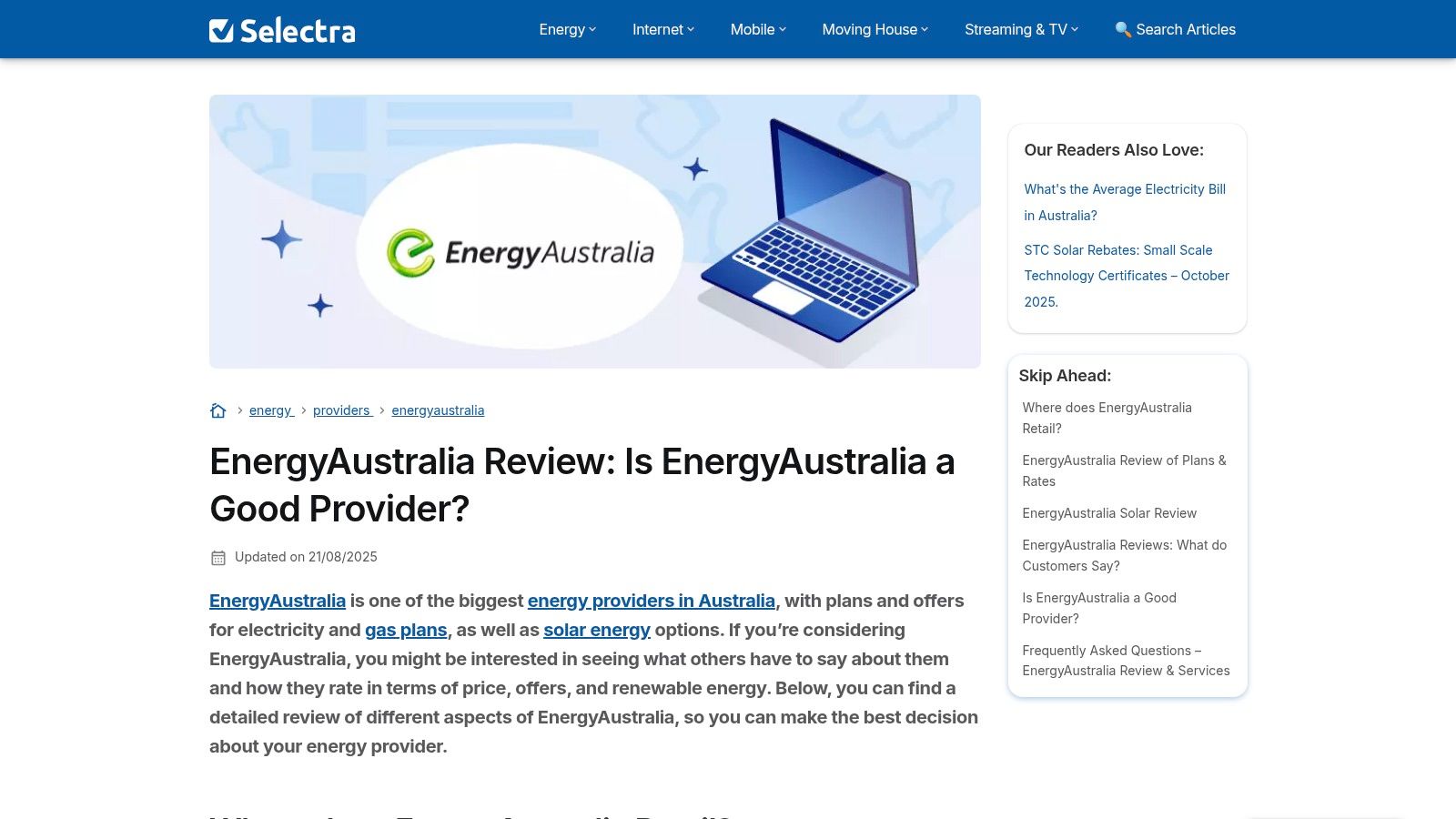
The platform’s strength lies in its synthesis of information. Instead of you needing to visit multiple review sites, Selectra collates ratings from sources like Trustpilot and ProductReview.com.au and presents them alongside its own analysis. It also provides clear, state-by-state tables for feed-in tariffs, complete with validation dates, giving you a reliable benchmark to compare against official figures.
How to Use the Site Effectively
Selectra’s Energy Australia solar reviews page is best used as a high-level research tool before you dive into the finer details on the official EnergyAustralia website.
- Get a Quick FiT Snapshot: Use the state-specific tables to quickly see the standard and premium FiT rates available in your area. This gives you an immediate sense of potential earnings.
- Gauge Overall Sentiment: The aggregated star ratings provide a balanced view of customer satisfaction, combining feedback from thousands of users across different platforms.
- Understand Market Position: Read the commentary to learn about EnergyAustralia's broader solar strategy, including its product scope and any identified gaps, such as the need for separate installers.
This consolidated approach saves you time and provides valuable context. By seeing both the numbers and the public perception side-by-side, you can form a more well-rounded opinion of EnergyAustralia's solar plans before committing.
Pros & Cons of Using Selectra Australia
| Pros | Cons |
|---|---|
| ✅ Single-page view of FiTs, plans, and review scores. | ❌ Data is from a third-party and may not be live. |
| ✅ Aggregates external ratings for a balanced view. | ❌ Requires cross-checking with the official EA site. |
| ✅ Highlights product gaps and market context. | ❌ Analysis may not cover niche or new plan details. |
Website: https://selectra.com.au/energy/providers/energyaustralia/review
7. Energy Matters – National FiT Comparison Including EnergyAustralia
To understand the real value of an EnergyAustralia solar plan, you need market context. Energy Matters provides this crucial perspective by offering a regularly updated, state-by-state comparison of feed-in tariffs from various retailers. It allows you to see exactly how EnergyAustralia’s rates, including its tiered ‘Solar Max’ structure, stack up against competitors in your specific area. This is an essential step for anyone conducting thorough Energy Australia solar reviews to benchmark their potential earnings.
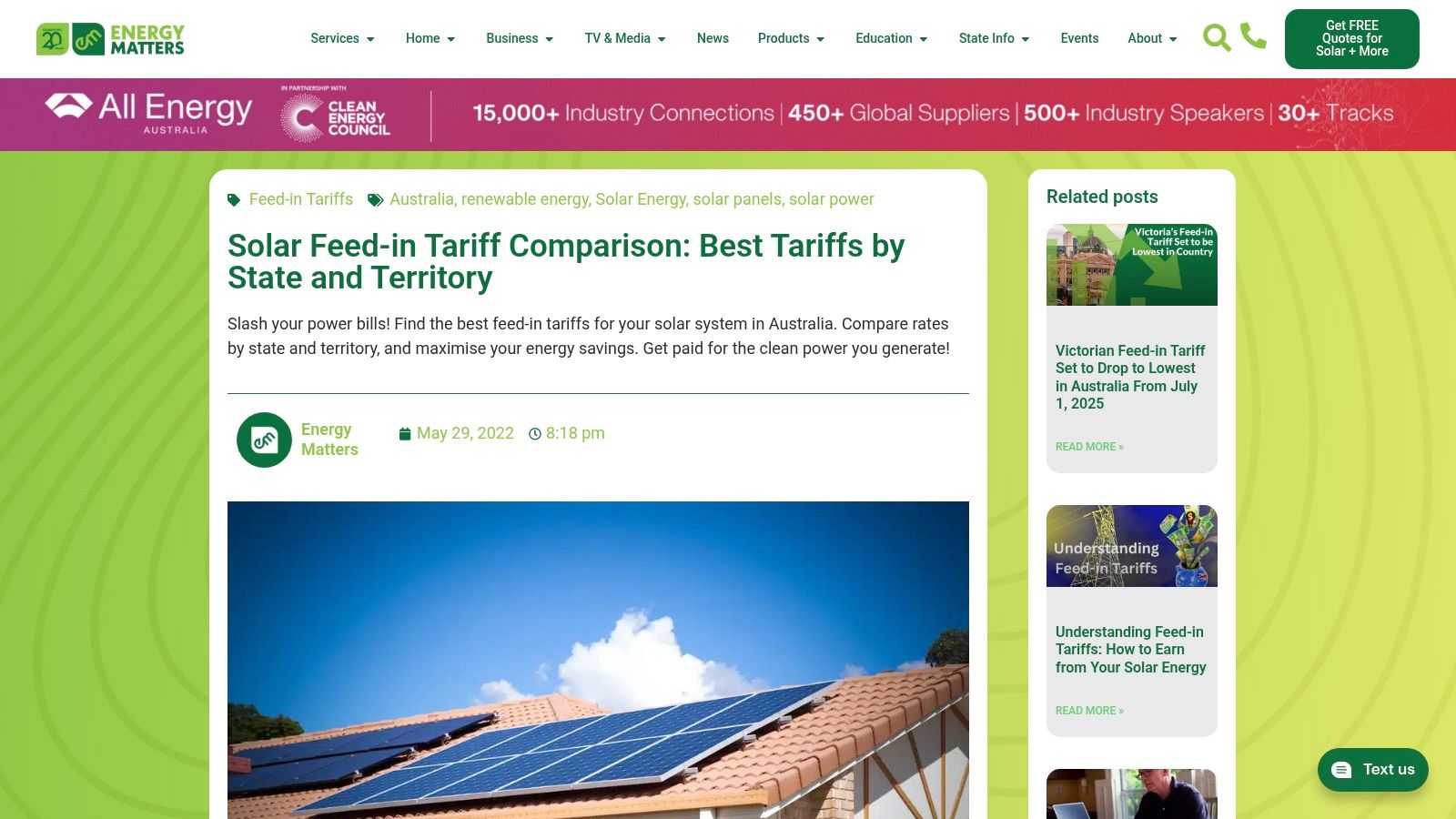
The platform presents clear, state-based tables that list the minimum and maximum FiTs offered by each major retailer. This makes it easy to spot where EnergyAustralia’s offers are most competitive. Beyond just numbers, Energy Matters also provides context on regulatory changes, such as proposed FiT cuts in Victoria, helping you understand the broader energy landscape.
How to Use the Site Effectively
The primary strength of Energy Matters is its ability to centralise competitive intelligence, turning data into actionable steps for homeowners.
- Benchmark FiT Rates: Use the comparison tables to see if EnergyAustralia's Solar Max FiT is a leading offer in your state or if other retailers provide a better flat rate.
- Stay Informed on Changes: Read the accompanying articles to understand why FiTs are changing and what future trends might impact your solar export income.
- Request Installer Quotes: The site doubles as a marketplace, allowing you to move from research to action by requesting quotes from accredited solar installers.
The site is also a valuable educational resource, offering solar buying guides and news that complement its data-driven comparisons. For those wanting to maximise their returns, understanding how to actively participate in the market is key, and you can learn more about how smart energy trading can generate revenue in our guide on how smart trading earns monthly payments.
Pros & Cons of Using Energy Matters
| Pros | Cons |
|---|---|
| ✅ Quick overview of how EA compares to competitors. | ❌ Aggregated tables may lag behind real-time tariff changes. |
| ✅ Context on regulatory FiT changes by state. | ❌ Primarily a comparison tool, lacks deep customer reviews. |
| ✅ Actionable tools to request installer quotes directly. | ❌ Data should always be verified on the official retailer site. |
Website: https://www.energymatters.com.au/renewable-news/best-feed-in-tariffs-australia/
EnergyAustralia Solar Reviews Comparison
| Item | Implementation Complexity 🔄 | Resource Requirements ⚡ | Expected Outcomes 📊 | Ideal Use Cases 💡 | Key Advantages ⭐ |
|---|---|---|---|---|---|
| EnergyAustralia – Solar tariffs, plans and support | Medium – navigating state-based FiTs and policies | Low – access via official website | Accurate, current solar tariffs and billing info | Users needing official, up-to-date tariff data | Most current official info; clear FiT explanations |
| ProductReview.com.au – Consumer reviews of EnergyAustralia | Low – user-generated reviews, simple browsing | Low – open access, large database | Varied user sentiment and service feedback | Checking real customer experiences before switching plans | Large volume of local, solar-specific reviews |
| Trustpilot – EnergyAustralia customer feedback | Low – platform for open reviews | Low – publicly accessible reviews | Transparent feedback with company responses | Assessing complaint handling and customer satisfaction | Company replies offer insight into issue resolution |
| Canstar Blue – EnergyAustralia solar plan and FiT explainer | Low – static comparison tables | Low – independent site with periodic updates | Summarized FiT benchmarking by state | Quick cross-check of EA tariffs vs competitors | Clear, easy-to-understand tariff summaries |
| SolarQuotes – News and analysis on EnergyAustralia FiT changes | Medium – in-depth analysis and trend breakdown | Low – educational content, no direct data feeding | Insight into FiT impacts and trade-offs | Understanding how tariffs affect solar payback | Independent, specialist commentary with detailed explanations |
| Selectra Australia – EnergyAustralia solar review and FiT snapshots | Low to Medium – aggregated data and ratings | Moderate – combines multiple data sources | Consolidated view of EA solar offerings and market position | Getting a broad perspective including user ratings | Single-page overview; aggregates external reviews |
| Energy Matters – National FiT comparison including EnergyAustralia | Low – regularly updated comparison tables | Moderate – marketplace plus guides | Comparative FiT data and actionable solar buying support | Users benchmarking tariffs and seeking installation quotes | Combines tariff comparisons with buying guides and referrals |
Making Your Final Decision: Beyond Standard Tariffs
Navigating the landscape of Energy Australia solar reviews and feed-in tariffs requires a balanced approach, and the resources we've explored provide the full picture. You've seen the official rates and plans directly from EnergyAustralia, weighed them against the unfiltered customer experiences on platforms like ProductReview and Trustpilot, and gained expert context from industry analysts at Canstar Blue, SolarQuotes, Selectra, and Energy Matters.
This comprehensive view reveals a crucial insight: choosing an energy retailer for your solar system is not a one-dimensional decision. While a competitive feed-in tariff is a significant drawcard, it's essential to look beyond the numbers. The reviews consistently highlight the importance of customer service, billing accuracy, and responsive support. A high tariff is less valuable if you spend hours on the phone resolving issues or deciphering complex bills.
Balancing Tariffs with Service and Future Potential
Your final decision should hinge on what you value most. Are you chasing the highest possible FiT, even if it comes with daily export limits or fluctuating customer service ratings? Or do you prioritise a stable, reliable energy partner with a strong support network, even if their tariff is slightly lower than the market leader?
Consider these key takeaways when making your choice:
- Look for Consistency: Analyse reviews over time. A single bad month might be an anomaly, but consistent complaints about billing or support on sites like Trustpilot and ProductReview are a significant red flag.
- Understand the Fine Print: As highlighted by Canstar Blue and SolarQuotes, always read the terms and conditions. Pay close attention to daily export caps, plan eligibility requirements, and whether the FiT is conditional on purchasing electricity from the same provider.
- Benchmark Against the Market: Use tools like Energy Matters and Selectra to ensure the offer you are considering is genuinely competitive in your state or distribution network. What seems like a good deal in isolation may be average when compared to other available options.
Evolving Beyond Passive Feed-in Tariffs
Most importantly, it's time to think beyond a simple, passive feed-in tariff. While FiTs provide a baseline return, they represent just one way to monetise your solar investment. The next evolution in home energy management involves actively participating in the energy market, a strategy that is especially powerful for households with a home battery.
This is where Virtual Power Plants (VPPs) come into play. A VPP allows you to intelligently sell your stored battery energy back to the grid during high-demand, high-price peak events. Instead of a fixed, low rate, you can access wholesale market prices, often generating monthly payments that significantly outperform standard FiT credits. This transforms your solar and battery system from a passive saver into an active, income-generating asset, giving you far more control and unlocking its true financial potential. As you finalise your decision based on current Energy Australia solar reviews, ensure your long-term strategy considers these powerful, future-focused opportunities.
Ready to move beyond basic feed-in tariffs and unlock the full earning potential of your solar and battery system? Discover how HighFlow Connect can help you earn more by intelligently trading your stored energy in the wholesale market. Explore your home's potential at HighFlow Connect today.


